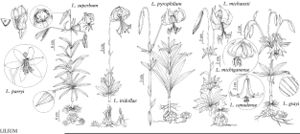Lilium pyrophilum
Novon 12: 94, figs. 1, 2. 2002.
Bulbs rhizomatous, occasionally branching dichotomously at 120° from main axis, 2.4–2.8 × 5.2–8.6 cm, 0.3–0.5 times taller than long, 2–3 years’ growth evident as annual bulbs, scaleless sections between these 0.3–2.5 cm; scales unsegmented, longest 1.1–1.9 cm; stem roots absent or sometimes present. Stems 0.6–1.6 m. Buds ± triangular in cross section. Leaves often concentrated proximally, occasionally scattered, usually in 1–12 whorls or partial whorls, 3–11(–15) leaves per whorl, barely to moderately ascending proximally, drooping at tips or not, ascending and appressed distally, 2.3–10.3(–12.2) × 0.8–2.4 cm, 1.6–7.6(–10.3) times longer than wide; blade narrowly elliptic, margins not undulate, apex acute, barely acuminate on distal leaves; veins and margins ± smooth abaxially. Inflorescences racemose, 1–7-flowered. Flowers pendent, not fragrant; perianth Turk’s-cap-shaped; sepals and petals reflexed 1/5–1/4 along length from base, yellow (occasionally pale yellow or yellow-orange) proximally, red-orange or dusky red (occasionally magenta, pinkish, pale orange, or red) distally, spotted magenta, not distinctly clawed, nectaries exposed, forming visible green star (or triangle, when only sepal nectaries are exposed); sepals with 2 parallel, often faint abaxial ridges, 6.7–8.9 × 1.1–1.7 cm; petals 6.3–8.7 × 1.5–2.2 cm; stamens strongly exserted; filaments parallel at first, then widely spreading, diverging 12°–28° from axis; anthers magenta or sometimes purple, 1.1–1.8 cm; pollen rust; pistil 3.4–6.4 cm; ovary 1.5–2.8 cm; style pale green, often spotted purple; pedicel 6.8–16.5 cm. Capsules 2.8–4.7 × 1.5–1.9 cm, 1.7–2.8 times longer than wide. Seeds not counted.
Phenology: Flowering summer (late Jul–mid Aug).
Habitat: Streamhead pocosins, sandhill seeps and streamsides, drainages in maintained powerlines
Elevation: 0–200 m
Distribution

N.C., S.C., Va.
Discussion
Lilium pyrophilum is narrowly endemic to the Sandhills region of southern Virginia, North Carolina, and northern South Carolina. The most ecologically intact populations occur on military bases in the Carolinas that are carefully managed to ensure the frequent fires that promote this fire-dependent lily; many of these fires are initiated by exploding ordnance.
Its close relative, Lilium superbum, occurs to the west in the upper Piedmont, and is not known from the Sandhills proper. Prior to the description of L. pyrophilum, specimens now assignable to it were masquerading in herbaria as other species, primarily L. michauxii. A. E. Radford et al. (1968) mentioned robust L. michauxii bog plants that resembled L. superbum; these are considered here as L. pyrophilum.
Discriminating between Lilium superbum and larger specimens of L. pyrophilum may require reference to several characters. The shorter, blunter, more ascending leaves of L. pyrophilum average fewer per whorl and are grouped in fewer whorls, but overlap with L. superbum is extensive. In L. pyrophilum the whorls with the largest number of leaves are often clustered nearer the ground, and distally the stem bears scattered, appressed leaves, whereas the taller L. superbum displays whorling more or less evenly along the stem, and the few scattered leaves above the whorls are not appressed. Lilium pyrophilum blooms somewhat later than L. superbum, though some overlap occurs. The floral tube of L. pyrophilum is longer because the perianth parts are reflexed farther down their lengths, but this difference is subtle.
Hybrids between Lilium michauxii and L. pyrophilum are known and often display the wide petals characteristic of the former species.
The manner and frequency of visits by ruby-throated hummingbirds [Archilochus colubris (Linnaeus), family Trochilidae] suggest that this species is involved in pollination of the Sandhills lily. The palamedes swallowtail [Papilio palamedes (Drury), family Papilionidae] also visits and pollinates this species.
Selected References
None.
